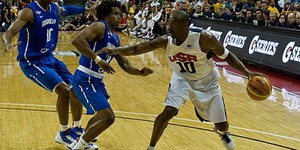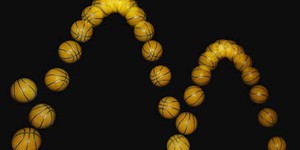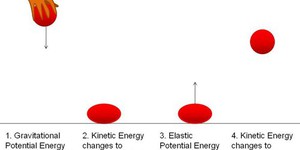The Physics of Bouncing a Ball | Science Project
Log In
Want to learn more? Check out these other resources:
Many sports use a ball in some way or another. We throw them, dribble them, hit them, kick them, and they always bounce back! What makes a ball so bouncy? In this experiment you can investigate the effect of air pressure on ball bouncing.
Read more
Playing basketball can be hard work. Players not only constantly run around the court, but just dribbling the basketball takes a lot of effort, too. Why is that? It has to do with how the basketball bounces. When the ball hits the court, its bounce actually loses momentum by transferring some of its energy into a different form. This means that to keep the ball bouncing, players must continually put more energy into the ball. In this sports science project, you will determine how high a…
Read more
Have you ever noticed that when you drop a basketball, its bounce does not reach the height you dropped it from? Why is that? When a basketball bounces, such as on a basketball court, its bounce actually loses momentum by transferring energy elsewhere. This means that to dribble the basketball, players must continually replace the transferred energy by pushing down on the ball. But what happens to the "lost" energy? As we know from physics, energy is not really lost, it just changes form. One…
Read more
The rebound rating is the ratio of the height the ball bounces to, divided by the height the ball was dropped from. Use the rebound rating to measure the bounciness of new tennis balls vs. balls that have been used for 10, 20, 50, and 100 games. Another idea to explore: does it matter what type of court the ball is used on? (See: Goodstein, 1999, 63-64.)
Read more
Think of hitting a baseball, heading a soccer ball into the net, or hitting a tennis ball with a racquet. Where the ball goes depends on...what? You can set up a simple model to start your investigation. You'll need a marble, a flat piece of wood, a flat piece of cardboard, a pencil, a ruler, a protractor, and a level surface. Lay down the cardboard down on a level surface and set up the flat piece of wood at one edge. The wood will act like a wall, and you're going to roll the marble at…
Read more
For example, think of hitting a baseball, heading a soccer ball into the net, or hitting a tennis ball with a racquet. Where the ball goes depends on...what? You can set up a simple model to start your investigation. You'll need a marble, a flat piece of wood, a flat piece of cardboard, a pencil, a ruler, a protractor, and a level surface. Lay down the cardboard down on a level surface and set up the flat piece of wood at one edge. The wood will act like a wall, and you're going to roll…
Read more
You might think that plants and animals have little in common with batteries, springs, or slingshots, but they actually do have something in common. Both living and non-living things store and transfer energy from one form to another. In this physics science fair project, you'll investigate this energy storage and transfer, not in a plant or animal, but in bouncy balls. You'll find out if there are limits on how much energy can be stored and if there are losses when the energy is transferred.
Read more
Explore Our Science Videos
Balloon Magic with Bernoulli's Principle
Build A Gumdrop Geodesic Dome!
Design and Launch Bottle Rockets










